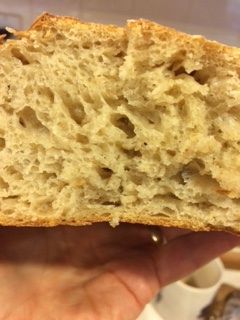November 17, 2016 - 10:12am

Question re: Bulk Fermentation times, temperature, S&F interval
Gurus:
If a recipe calls for e.g. a 2.5 hour bulk fermentation time at 70 - 75 F with 2 stretch and folds at 50 minute intervals, should I extend the stretch and fold interval if the temperature is 65F? I know the bulk fermentation will be longer b/c of the lower temperature. The question is should I make the stretch and folds at say 70 minute intervals b/c things are going more slowly?
Thank you in advance for responses.
hester


Sounds fine to me. S+F is to develop gluten. If two S+F are enough the first way then it'll be enough the second way. If you think it needs more then you can add a third. Which is how one should treat a recipe anyway. And the same if it needs less. The way how to perform them is to space them out enough so that the dough relaxes in between and then you do another. Both ways you describe do this.
Not a guru just an enthusiast.
It's actually Norwich SD, here (http://www.wildyeastblog.com/my-new-favorite-sourdough/). It is a slight alteration of Hamelman and i think it's better than his Vermont SD. There's a tad more rye and the levain is 100% hydration rather than Hamelman's 125%. Also I add more water than they do at the blog (or Hamelman). It's my go-to recipe now, when I want a plain sd bread w a ton of flavor. I started using French T65 and finally my husband on his own praised it.... lol
Thanks Abe,
hester
You could use warmer water. This will help keep things moving. Sometimes the top of the refrigerator is warmer as well. But either way, the S&F interval won't matter. At 50 minutes, the gluten will be relaxed enough anyway. You can let it go longer if you know the bulk ferment will be longer, but it doesn't really matter.
Today I had time, so I kept it at room temp, increased the intervals to 80 minutes and when I returned home I found it had risen nicely. Will bench rest and shape and refrigerate overnight. It's a kind of experiment which I'll report back on after my bake tomorrow.
Thanks again
hester
Actually, I would keep the interval the same and then let the dough rise for a longer time undisturbed. You don't want to take the risk of knocking out too much of the gases late in the bulk ferment. I have been known to wait as little as 20 minutes between S&Fs if I'm pressed for time and have to go out. As long as the dough is properly developed (stretchy and silky), you've probably done enough!
In the past I have done just what you say. Stayed with the 50 minute interval despite the ambient temperature being 5-10F less. Today I experimented with a 75 - 80 minute interval. Dough is now shaped in refrigerated for it's final rise. I'll post tomorrow here what the results are. Thank you again
hester
It gets that extra time undisturbed as well. So it's a difference between a six and 2 threes. Stretch and Folds should not de-gas the dough too much when done properly. And while we don't want to knock too much gas out we do knock out the larger bubbles when shaping anyway otherwise you'd get a misshapen loaf with some very big air pockets. S+F don't have to be strictly done at any certain time. Incorporate enough of them to develop the gluten and they may be done pretty much anytime. If I don't wish to hang around I'd squeeze them in closer together towards the beginning and if I have more time to spend I'd spread them out.
Your reply above just disprove that. Lol. Thanks again for the explanation. It's always better for me when I understand something. And yes, I try not to de-gas too much when I do the stretch and folds.
Loaves are nicely risen right now, still in fridge and waiting for my oven to heat up. I have gone from making larger loaves to making smaller 500 gm loaves. Easier to manage and double as gifts.
Thanks again, Abe, guru.
hester
What Lazy Loafer says is true. We do want to preserve the gas bubbles so we don't de-gas fully when shaping like traditionally has been done. And while S+F will knock some out, you want to perform them without tightening up too much. When doing the S+F don't go beyond the resistance of the dough and don't tighten it up. With each S+F it will resist more. Don't fight it.
Go to www.breadwerx.com where Trevor J Wilson has some great videos and explanations. When he forms the dough he brings it to enough gluten formation using a special scooping method so that the S+F are a nice added extra but not essential. He then performs the S+F how much or little he sees fit or can spend time on it.
There is one video on how to make bigger holes with lower hydration dough. Takes you through every step.
He is a true guru.
Now, not so much. I wanted to 'prove' to myself I could do it. But honestly I like vehicles for my butter, cheese and jam. With my plain breads I don't want a dense loaf, but rather one with smaller and medium holes dispersed throughout. I'll see what happens today. With my loaded loaves, with other grains, seeds etc, I like them denser.
Thanks again.
hester
Next time I'll stick to 50 minute schedule and then proceed. I learn a lot from my errors.
hester
The crumb is fine. The taste: great. Nice tang notes.